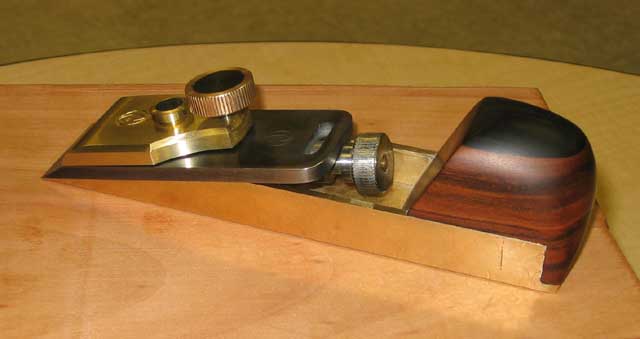
Ron Gerard says "The body is made fron channel brass that I got from Alan Metals located in Redwood City. Of course, the width of the channel defines the width (1.5") of the plane. The length is 6.5".
Some of the design features come from Lie-Nielsen and some of the features are mine. If you look at the front of a Lie-Nielsen chisel plane, you'll see a resemblance. I didn't like the knob at the back (it looked uncomfortable to me) so I made an infill of plum and Gabon ebony. The infill fits very nicely in the curve between my thumb and index finger. The front angle is 12.5 degrees and the blade angle is 25 degrees. I soldered a solid piece of brass to the channel under the blade and used the disk sander to shape it to the 12.5 degree.
The blade was made from annealed O1 tool steel. It was ground to shape and two slots were milled into the blade. The front slot is under the small brass and delrin knob and the rear slot is used by the 316 stainless steel adjustment knob. I used 316 SS for the adjustment knob because I thought it would wear better than brass against the hardened blade. The "O" in O1 designates an oil quench. Ron Hock charged me $5.00 to have my blade heat treated with his blades as opposed to $60.00 that my local heat treater charged. BAWA member Jim Voos allowed me to cut the two slots in the blade on his bench top milling machine. The brass pressure plate was made with a hacksaw, disk sander and a sanding drum set up in a drill press. The threads for the three knobs are all 10-32. If I were to make a similar sized plane, I think that I would use 12-32 threads instead. The two brass knobs were made by turning the knobs to final shape including the pockets for the delrin,then drilling and tapping a center hole in which a 10-32 screw was soldered. The delrin was glued in with epoxy, then placed back in the lathe to blend and finish the top surface.
I soldered a square piece of brass to the back of the body under the infill. There is a 10-32 flat head brass screw through the plum piece to keep it in place and the ebony added to hide the screw. The circular engraving on the sides of the body was done in the drill press using a length of maple dowel that had valve grinding compound applied to the end. A fence was used to keep the lines of circles straight. The hardest part of the job, by far, was the knurling. 316 Stainless is hard to work in any kind of operation and my knurling skills are rusty."
